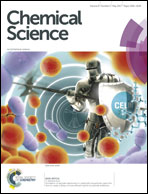Reactivity studies on [Cp′Fe(μ-I)]2: nitrido-, sulfido- and diselenide iron complexes derived from pseudohalide activation†
Abstract
The iron half-sandwich [Cp′Fe(μ-I)]2 (Cp′ = 1,2,4-(Me3C)3C5H2, 1) reacts with the pseudohalides NCO−, SCN−, SeCN− and N3− to give [Cp′Fe(μ-NCO)]2 (2), [Cp′Fe(μ-S)]2 (3), [Cp′Fe(μ-Se2)]2 (4) and [Cp′Fe(μ-N)]2 (5), respectively. Various spectroscopic techniques including X-ray diffraction, solid-state magnetic susceptibility studies and 57Fe Mössbauer spectroscopy were employed in the characterization of these species. Mössbauer spectroscopy shows a decreasing isomer shift with increasing formal oxidation state, ranging from Fe(II) to Fe(IV), in complexes 1 to 5. The sulfido-bridged dimer 3 exhibits strong antiferromagnetic coupling between the Fe(III) centers. This leads to temperature-independent paramagnetism (TIP) at low temperature, from which the energy gap between the ground and the excited state can be estimated to be 2J = ca. 700 cm−1. The iron(IV) nitrido complex [Cp′Fe(μ-N)]2 (5) shows no reactivity towards H2 (10 atm), but undergoes clean reactions with CO (5 bar) and XylNC (Xyl = 2,6-Me2C6H3) to form the diamagnetic isocyanate and carbodiimide complexes [Cp′Fe(CO)2(NCO)] (7) and [Cp′Fe(CNXyl)2(NCNXyl)] (8), respectively. All compounds were fully characterized, and density functional theory (DFT) computations provide useful insights into their formation and the electronic structures of complexes 3 and 5.
![Graphical abstract: Reactivity studies on [Cp′Fe(μ-I)]2: nitrido-, sulfido- and diselenide iron complexes derived from pseudohalide activation](/en/Image/Get?imageInfo.ImageType=GA&imageInfo.ImageIdentifier.ManuscriptID=C7SC00570A&imageInfo.ImageIdentifier.Year=2017)


 Please wait while we load your content...
Please wait while we load your content...